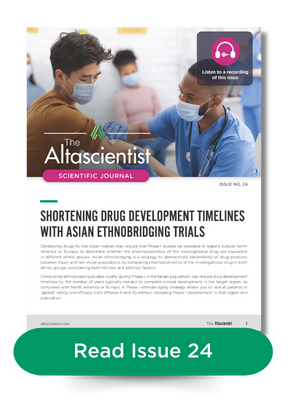ISSUE NO. 24 — Shortening Drug Development Timelines with Asian Ethnobridging Trials

Conducting ethnobridging studies locally, during Phase I clinical trials, in the target population, can reduce drug development timelines by the number of years typically needed to complete clinical development in the target region, as compared with North America or Europe. A Phase I ethnobridging strategy allows you to recruit patients in “global” safety and efficacy trials (Phases II and III) without repeating Phase I development in that region and population.
In Issue 24 of The Altascientist:
• The importance of Asian ethnobridging in clinical research
• Bridging requirements per the ICH E5 Guidance
• Strategic program considerations per the ICH E7 Guidance
• Accelerating Asian drug development
• Language requirements for global clinical trials
• Altasciences’ expertise and experience with ethnobridging
The Importance of Asian Ethnobridging in Clinical Research
Over 60% of the world’s population is considered part of the diverse group of ethnicities commonly referred to as Asian, with each ethnicity having a distinct genetic profile. A 2019 systemic review identified 49 different ethnic categories that were classified as “Asian” in pharmacogenetic studies. Within Asian subgroups, the known differences in pharmacogenetics are generally previously identified variants, which are significantly more or less prevalent in Asians as compared to other populations.
Two identified intrinsic factors that affect drug metabolism are that Asians are more commonly poor metabolizers of cytochrome P450 (CYP) 2C19, and carriers of the human leukocyte antigen (HLA)-B*15:02 allele. The relative risk increase was shown to vary between genes and drugs but could be more than 100-fold higher in Asians. The resulting adverse events that are more prevalent in Asians range from reduced drug efficacy to severe cutaneous skin reactions.
Extrinsic factors (e.g., diet and lifestyle), socioeconomic factors, environmental influences (e.g., amount of sunshine, and air and water quality), as well as differences in medical practice, may have an impact on the pharmacokinetics (PK) of certain drugs in Asian populations.
Because of these differences, drugs were generally developed in Asia on a timeline that was different from the Western regions of the world. By the late 90s and early 2000s, a drug development time-lag of as much as eight to 10 years was observed by consumers for drugs (many for the most critical indications such as cancer and heart disease) to reach Asian markets.
Explore all issues of The Altascientist in our Resource Center. And don’t forget to subscribe to “The Altascientist: Audiobooks” on Spotify, Apple Podcasts, or wherever you get your audio content.